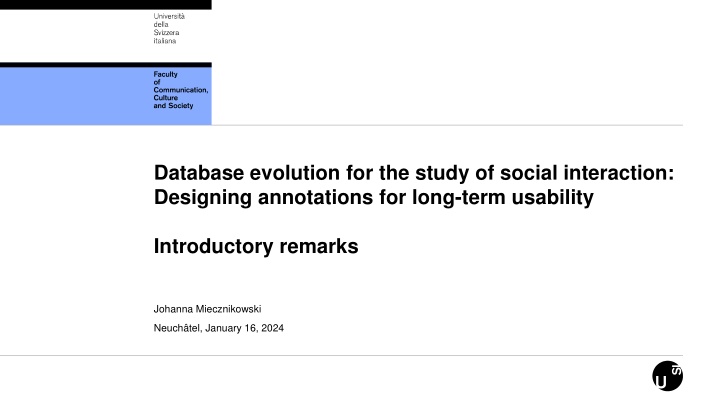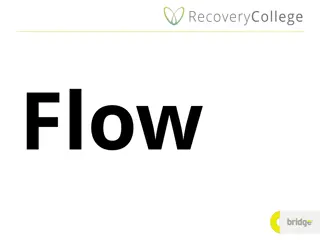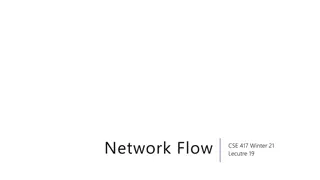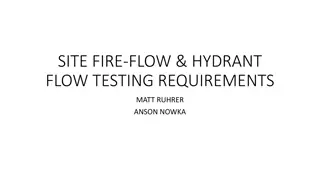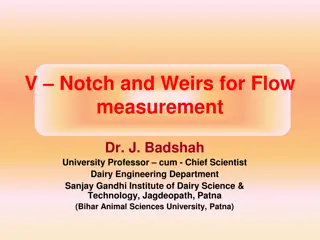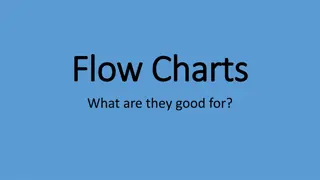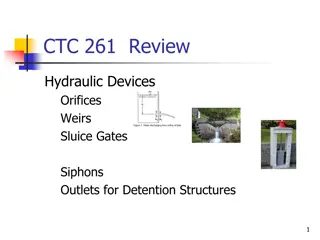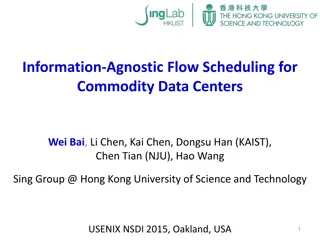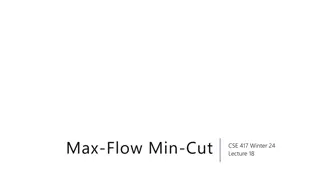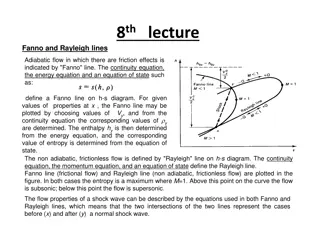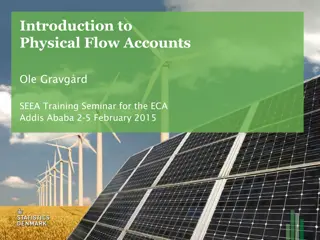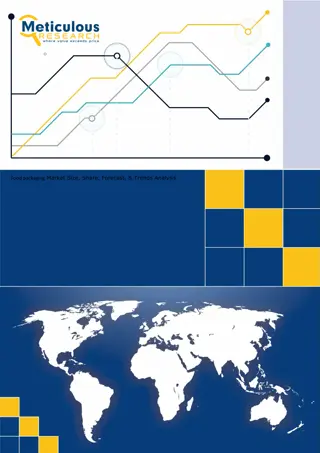Overview of IC Design Flow and Physical Design Details
The process of IC design involves various stages like design entry in HDL, synthesis, simulation, physical design including DRC, LVS, and ERC checks, and finally tape-out. Physical design ensures the layout meets design rules. Examples include OpenGL ES GPU and ARM Hypervisor development in Taiwan, emphasizing system verification and simulation.
Download Presentation

Please find below an Image/Link to download the presentation.
The content on the website is provided AS IS for your information and personal use only. It may not be sold, licensed, or shared on other websites without obtaining consent from the author.If you encounter any issues during the download, it is possible that the publisher has removed the file from their server.
You are allowed to download the files provided on this website for personal or commercial use, subject to the condition that they are used lawfully. All files are the property of their respective owners.
The content on the website is provided AS IS for your information and personal use only. It may not be sold, licensed, or shared on other websites without obtaining consent from the author.
E N D
Presentation Transcript
Database evolution for the study of social interaction: Designing annotations for long-term usability Introductory remarks Johanna Miecznikowski Neuch tel, January 16, 2024
Data-sharing skills in corpus-based research on talk-in-interaction (CHORD-Talk-in-interaction) J r me Jacquin Johanna Miecznikowski Andrea Rocci Sara Greco Nina Profazi CHORD Lorenza Mondada Martin Luginb hl Talk-in-interaction Simona Pekarek 2 Miecznikowski / Workshop:Database evolution for the study of social interaction: Designing annotations for long-term usability, Neuch tel, January 16, 2024
To annotate (a document) to add notes to (a document) Writing practice; Sequentiality: addition of information to an existing document; Is typically produced and stored in close proximity to the document; Each annotation typically relates to a document part rather than to the entire document; Typically has pragmatic goals related to reading and further uses of the document. Image Credit: Adapted from Provenance Online Project, Detail of leaf k6r of an incunable edition of St. Thomas Aquinas s In duodecim libros Metaphysicorum Aristotelis expositio, via Flickr (CC BY 2.0). Fr javille 2017 Kalir & Garcia 2021 3 Miecznikowski / Workshop:Database evolution for the study of social interaction: Designing annotations for long-term usability, Neuch tel, January 16, 2024
Annotation of digital linguistic corpora The annotation of digital text and discourse data adds information that can be processed by search engines and other software, mainly to analyse data in view of specific research interests (corpus query, statistical analysis, collection building); to create intertextual and intermedial links between parts of different documents (e.g. timecode stamps to align transcripts and audio files); to visualise data; to train machine learning algorithms. Information commonly encoded by annotation: In documents structured by typographical means and layout: explicit structural mark-up; Morphosyntax: tokenisation (e.g. grouping strings into words), PoS, syntactic trees; Lemmatisation; Normalisation and translation; Named Entity Recognition (mark-up of proper names / topics relatable to a knowledge base); Semantic, pragmatic, interactional annotation, coding (social sciences). 4 Miecznikowski / Workshop:Database evolution for the study of social interaction: Designing annotations for long-term usability, Neuch tel, January 16, 2024
Where and how are digital annotations stored? in close proximity? When annotating handwritten or printed texts, annotations are typically inscribed onto the same material support as the source text or a note is produced that is pinned to, or sticked onto, the original document. Annotations differ from record cards , which are stored in separate containers and aim at reorganising the data (e.g. alphabetically or by topics). In digital environments, this distinction is blurred. An annotation is a database record of a special kind, i.e. a record that refers to a portion of the original text in such a way that a user can automatically access the record from the text and vice versa. Mutual accessibility is guaranteed by inline annotation or by referencing systems that operate with identifiers, within or across documents. 5 Miecznikowski / Workshop:Database evolution for the study of social interaction: Designing annotations for long-term usability, Neuch tel, January 16, 2024
XML inline tokenisation (token categories: u, incident; u attribute: who) TEI 2007, 8.3.3. Tokenisation realised by stand- off XML annotation (token category: segment with various attributes, among which segment start / end in original text) St hrenberg 2014:170 Original text (ELAN speaker tiers): Semantic, interactional, multimodal annotation of epistemic constructions: - identification of tokens in .eaf file (reference to portion of original text via timecode) - detailed description in .xlsx file (reference to tokens in .eaf file via tier and identifier). Jacquin et al. 2022:12, ex. 3 (truncated) ELAN annotation tiers: ID marqueur 1 ID port e 1 Excel table: ID marqueur ID port e 1 1 6 Miecznikowski / Workshop:Database evolution for the study of social interaction: Designing annotations for long-term usability, Neuch tel, January 16, 2024
Specific problems related to the annotation of audio/video corpora of talk-in-interaction Hopper 1987, Cresti 2005, Auer 2009, Selting et al. 2011 Pekarek Doehler, De Stefani & Horlacher 2015, Voghera 2017 Mondada 2018 Properties of spoken language, emergent grammar, multimodality: Interactional linguistics faces theoretical problems concerning the segmentation and categorisation of phenomena that have direct implications for transcription and annotation (What is a turn? What is a speaker contribution? What is a turn constructional unit? What is an intonation phrase? Which multimodal practices co-occur with speech? etc.). 7 Miecznikowski / Workshop:Database evolution for the study of social interaction: Designing annotations for long-term usability, Neuch tel, January 16, 2024
Specific problems related to the annotation of audio/video corpora of talk-in-interaction Transcribed audio/video data raise formal and technical problems related to data structures, to available software, standards and communities, which influence annotation practices in our field. Two examples: Multimodal interaction data are represented by sets of video, audio, and transcript files. This composite nature of the basic dataset raises interesting problems, for instance the question of the status of transcripts within such sets. Transcripts list actions realised by several co-present participants, admitting the possibility of simultaneous events (overlap, multimodality, multiactivity). Their logical structure does not correspond to the dominant structural model underlying written digital texts, which is the hierarchical tree . Because of this deviance, it is difficult to use ready-made widespread software solutions for annotation. Schmidt (2023)[2005] 8 Miecznikowski / Workshop:Database evolution for the study of social interaction: Designing annotations for long-term usability, Neuch tel, January 16, 2024
Are time-aligned transcripts annotations of audio and video recordings (ELAN)? [ ] [ ] Should further annotation refer to the transcribed text or to the timeline? [ ] TIGR ev-6a .eaf TIGR ev-6a .txt 9 Miecznikowski / Workshop:Database evolution for the study of social interaction: Designing annotations for long-term usability, Neuch tel, January 16, 2024
Specific problems related to the annotation of audio/video corpora of talk-in-interaction Transcribed audio/video data raise formal and technical problems related to data structures, to available software, standards and communities, which influence annotation practices in our field. Two examples: Multimodal interaction data are represented by sets of video, audio, and transcript files. This composite nature of the basic dataset raises interesting problems in annotation as a digital writing practice. The logical structure of transcripts does not correspond to the dominant structural model underlying written digital texts, which is the hierarchical tree structure. Because of this deviance, it is difficult to use ready-made widespread software solutions for annotation. Schmidt (2023)[2005] 10 Miecznikowski / Workshop:Database evolution for the study of social interaction: Designing annotations for long-term usability, Neuch tel, January 16, 2024
Transcripts list actions realised by several co-present participants, admitting the possibility of simultaneous events (overlap, multimodality, multiactivity). Accordingly, the data structure of transcribed dialogue can be conceived as a quite flat structure: sets of lists of annotations related to each other only via a timeline (e.g. in the ELAN example) or a graph structure that unfolds unidirectionally in time (in EXMARALDA). In contrast, most software for encoding, annotating and searching text assumes that texts are trees. XML, the most important mark-up language used in corpus linguistics, also embeds this assumption. This raises practical problems, for example: There are still no widely accepted technical standards for annotating overlapping speech. Tree- based workarounds, e.g. TEI proposals, coexist with more specific solutions. Widely used query processors developed for hierarchically organised documents, when applied to transcripts containing overlapping speech, struggle with apparently simple tasks such as calculating the distance between word tokens. Some research tasks require complex annotation projects with elaborate schemes, multiple annotators and a controlled workflow of data curation. Annotation tiers in transcript editors are too limited (e.g. ELAN) or not sufficiently developed and used (e.g. Sextant). Inversely, plat- forms that support complex annotation projects, e.g. INCEpTION, share mainstream assumptions about text structure and do not offer specific support for the annotation of dialogue. Schmidt (2023)[2005] TEI 2007, 16.9 Frick, Helmer & Schmidt 2022 Brugman & Russel 2004 Klie et al. 2018 W rner 2009 11 Miecznikowski / Workshop:Database evolution for the study of social interaction: Designing annotations for long-term usability, Neuch tel, January 16, 2024
Annotation of no ormai anche carola lha capito (TIGR ev-4) in INCEpTION as an utterance. To optimise the program s performance, this annotation was made on a .txt file. The graphical layout of the .txt file (courier new font) is lost. Discontinous units are annotated including irrelevant material. To annotate parts of the utterance with greater precision, the text is reported manually in annotation fields. 12 Miecznikowski / Workshop:Database evolution for the study of social interaction: Designing annotations for long-term usability, Neuch tel, January 16, 2024
Sharing annotated audio/video and transcribed data Researchers working with audio/video data may share annotations with two goals: Case 1: Annotations have been made in view of specific research goals and are shared as open research data that give insight into the researcher s work and allow others to reuse them or conduct similar research. Case 2: A researcher publishes a set of audio/video data and associated transcripts and adds basic annotations (e.g. word tokenisation) to increase the range of uses that can be easily made of the data. Both cases raise questions as to data structures, file formats, metadata, the methodological documentation to be provided, places of storage, scenarios of data visualisation and query. Case 2, moreover, raises the question of assessing what basic annotations the community probably expects, which collaborations (with data specialists, corpus linguists, corpus hosting institutions) can be envisaged and what can realistically be achieved with the available resources. 13 Miecznikowski / Workshop:Database evolution for the study of social interaction: Designing annotations for long-term usability, Neuch tel, January 16, 2024
References Auer, P. (2009). On-line syntax: Thoughts on the temporality of spoken language. Language Sciences 31, pp. 1-13. Brugman, H., Russel, A. (2004). Annotating Multimedia/ Multi-modal resources with ELAN. In: Proceedings of LREC 2004, Fourth International Conference on Language Resources and Evaluation. Cresti, E. (2005). Enunciato e frase: teoria e verifiche empiriche. In M. Biffi, O. Calabrese & L. Salibra (Eds.), Italia linguistica: discorsi di scritto e di parlato (pp. 249-261). Siena, Protagon. Fr javille, E., (2017). Les annotations num riques 1e partie. La partition num rique, October 10, 2017, https://www.partitionnumerique.com/notation-musicale/annotations/les-annotations-numeriques-1e-partie/ Frick, Elena / Helmer, Henrike / Schmidt, Thomas (2022): Querying Interaction Structure: Approaches to Overlap in Spoken Language Corpora. In: Proceedings of the 13th Conference on Language Resources and Evaluation (LREC 2022), Marseille, 20-25 June 2022, 715 722. Jacquin, J., Keck A. C., Robin, C. & Roh, S. (2022). Guide d annotation du projet POSEPI. Universit de Lausanne Fonds National Suisse de la recherche. doi: 10.5281/zenodo.7266737 Kalir, R., Garcia, A. (2021). Joining the great conversation The fundamental role of annotation in academic society. Impact of Social Sciences Blog, May 28, 2021. https://blogs.lse.ac.uk/impactofsocialsciences/2021/05/28/joining-the-great-conversation-the-fundamental-role- of-annotation-in-academic-society/ Klie, J.-C., Bugert, M., Boullosa, B., Eckart de Castilho, R. and Gurevych, I. (2018): The INCEpTION Platform: Machine-Assisted and Knowledge-Oriented Interactive Annotation. In Proceedings of System Demonstrations of the 27th International Conference on Computational Linguistics (COLING 2018), Santa Fe, New Mexico, USA. 14 Miecznikowski / Workshop:Database evolution for the study of social interaction: Designing annotations for long-term usability, Neuch tel, January 16, 2024
References Mondada Lorenza. (2018). Multiple Temporalities of Language and Body in Interaction: Challenges for Transcribing Multimodality. Research on Language and Social Interaction Volume 51, 2018 - Issue, , 85-106. https://doi.org/10.1080/08351813.2018.1413878 Pekarek Doehler, S., De Stefani, E., Horlacher A.-S. (2015): Time and emergence in grammar: Dislocation, topicalization and hanging topic in French talk-in-interaction. Amsterdam: John Benjamins. Schmidt, T. (2023) [2005]. Computergest tzte Transkription. Modellierung und Visualisierung gesprochener Sprache mit texttechnologischen Mitteln. G ttingen, Verlag f r Gespr chsforschung. Selting, M., Auer, P., Barth-Weingarten, D., Bergmann, J. , Bergmann, P., Birkner, K., Couper-Kuhlen, E., Deppermann, A., Gilles, P., G nthner, S., Hartung, M., Kern, F., Mertzlufft, C., Meyer, C., Morek, M., Oberzaucher, F., Peters, J. , Quasthoff, U., Sch tte, W., & Uhmann, S. (2011). A system for transcribing talk- in-interaction: GAT 2 translated and adapted for English by Elizabeth Couper-Kuhlen and Dagmar Barth- Weingarten. Gespr chsforschung, 12, 1-51. St hrenberg, M. (2014). Extending standoff annotation. In Proceedings of the Ninth International Conference on Language Resources and Evaluation (LREC'14), pages 169 174, Reykjavik, Iceland. European Language Resources Association (ELRA). TEI Consortium, eds. TEI P5 (2007). Guidelines for Electronic Text Encoding and Interchange, version 4.7.0, last updated on 16th November 2023. TEI Consortium. http://www.tei-c.org/Guidelines/P5/. Voghera, M. (2017). Dal parlato alla grammatica: costruzione e forma dei testi spontanei. Roma: Carocci. W rner K., (2009). Werkzeuge zur flachen Annotation von Transkriptionen gesprochener Sprache. Bielefeld, Bielefeld University; 2009. 15 Miecznikowski / Workshop:Database evolution for the study of social interaction: Designing annotations for long-term usability, Neuch tel, January 16, 2024
